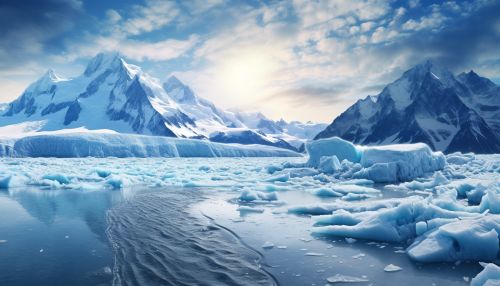Ice Flow
Introduction
Ice flow refers to the movement of glacier ice under the influence of gravity. It is a fundamental process in the cryosphere, which is the frozen water part of the Earth system. The study of ice flow is crucial to understanding the dynamics of glaciers and ice sheets, and their response to climate change.


Mechanics of Ice Flow
Ice flow is governed by the principles of rheology, the study of the flow of matter. Glaciers and ice sheets are considered as viscoelastic materials, which exhibit both viscous and elastic characteristics when undergoing deformation. The flow of ice is primarily influenced by the following factors:
- Stress: The force per unit area applied to the ice, which can be due to the weight of the overlying ice or external forces such as wind.
- Strain rate: The rate at which deformation occurs in the ice.
- Temperature: The temperature of the ice affects its rheological properties, with colder ice being more resistant to flow.
- Impurities: The presence of impurities such as dust or volcanic ash can influence the flow of ice.
Types of Ice Flow
There are two primary types of ice flow:
- Basal sliding: This occurs when the ice slides over the bedrock beneath it. This type of flow is common in temperate glaciers, which are at the melting point at their base.
- Internal deformation: This involves the deformation of the ice crystals themselves, and is the dominant type of flow in cold, polar glaciers.
Ice Flow and Climate Change
Ice flow plays a critical role in the response of glaciers and ice sheets to climate change. As the climate warms, the flow of ice can accelerate, leading to increased rates of sea level rise. Understanding the dynamics of ice flow is therefore crucial for predicting future sea level rise and assessing the potential impacts of climate change.
Measurement and Modelling of Ice Flow
The measurement of ice flow is typically achieved through a combination of field observations, remote sensing techniques, and numerical modelling. Field observations can include the use of GPS to track the movement of the ice, while remote sensing techniques such as satellite imagery can provide a broader view of ice flow patterns. Numerical modelling, using mathematical equations to represent the physical processes involved in ice flow, is a powerful tool for predicting future changes in ice flow in response to climate change.
Conclusion
The study of ice flow is a complex and fascinating field, with important implications for our understanding of the Earth's climate system. By studying the mechanics and dynamics of ice flow, scientists are able to gain insights into the past, present, and future behavior of glaciers and ice sheets, and the potential impacts of climate change.
